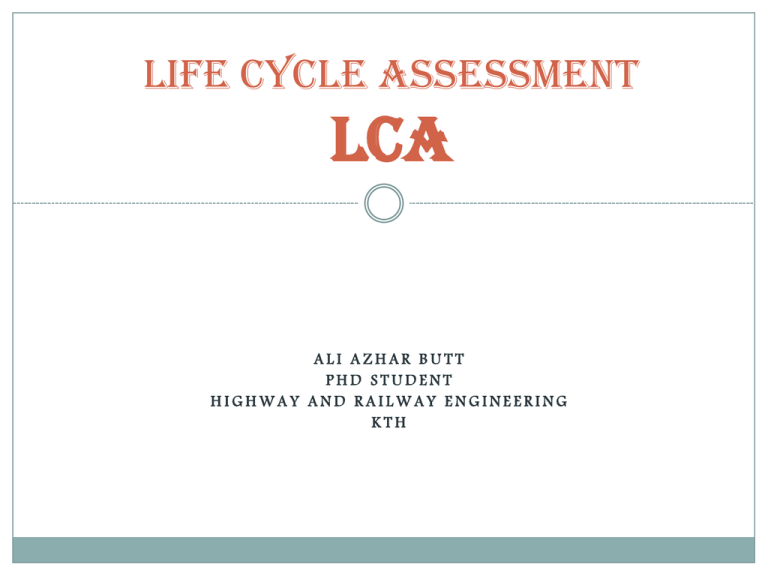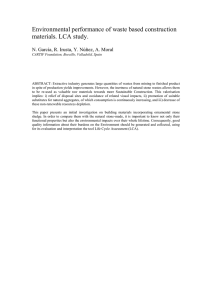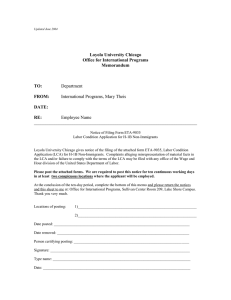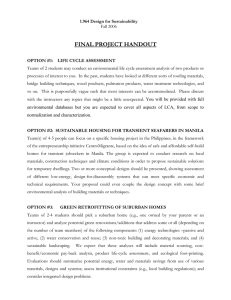life cycle assessment
advertisement

LIFE CYCLE ASSESSMENT LCA ALI AZHAR BUTT PHD STUDENT HIGHWAY AND RAILWAY ENGINEERING KTH Publications MASTER THESIS Butt, A.A. (2009), “Low Temperature Performance of Wax Modified Mastic Asphalt”, Master thesis Trita-VT 09:04, Royal Institute of Technology, KTH, Stockholm, Sweden JOURNAL PUBLICATIONS Edwards, Y., Tasdemir, Y. and Butt, A.A. (2010), “Energy saving and environmental friendly wax concept for polymer modified mastic asphalt”, Materials and Structures, Vol 43, supplement 1, 123-131 Butt, A.A., Jelagin, D., Tasdemir, Y. and Birgisson, B. (2010), “The Effect of Wax Modification on the Performance of Mastic Asphalt”, International Journal of Pavement Research and Technology, Vol 3, No. 2, 86-95 Butt, A.A., Mirzadeh, I., Toller, S. and Birgisson, B. (2012), “Life Cycle Assessment Framework for asphalt pavements; Methods to calculate and allocate energy of binder and additives”, under review in International Journal of Pavement Engineering Mirzadeh, I., Butt, A.A., Toller, S. and Birgisson, B. (2012), "Life Cycle Cost Analysis Based on Time and Energy Entities for Asphalt Pavements", under review in International Journal of Pavement Engineering Butt, A.A., Birgisson, B. and Kringos, N. (2012), "Considering the benefits of asphalt modification using a new technical LCA framework", TO BE SEND FOR PUBLICATION Butt, A.A., Mirzadeh, I., Toller, S. and Birgisson, B. (2012), "Considering recyclable asphalt and sub-structure aggregates in a life cycle assessment of the asphalt pavement", TO BE SEND FOR PUBLICATION Mirzadeh, I., Butt, A.A., Toller, S. and Birgisson, B. (2012), “Life cycle Assessment as a feedback system for Life cycle Cost and Mechanistic Calibrated design model", TO BE SEND FOR PUBLICATION CONFERENCES Butt, A.A., Tasdemir, Y. and Edwards, Y. (2009), “Environmental friendly wax modified mastic asphalt”, II International Conference on environmentally friendly roads, ENVIROAD, 15-16 Oct, Warsaw, Poland Butt, A.A., Birgisson, B. and Kringos N. (2012), “Optimizing the Highway Lifetime by Improving the Self Healing Capacity of Asphalt”, Fourth Transportation Research Arena (TRA), 2326 April, Athens, Greece Butt, A.A., Mirzadeh, I., Toller, S. and Birgisson, B. (2012), “Bitumen Feedstock Energy and Electricity production in Pavement LCA”, ISAP 2012 international Symposium on Heavy Duty Asphalt Pavements and Bridge Deck Pavements, 23-25 May, Nanjing, China. Mirzadeh, I., Butt, A.A., Toller, S. and Birgisson, B. (2012), "A Life Cycle Cost Approach based on the Calibrated Mechanistic Asphalt Pavement Design Model", ISAP 2012 international Symposium on Heavy Duty Asphalt Pavements and Bridge Deck Pavements, 23-25 May, Nanjing, China Butt, A.A., Jelagin, D., Birgisson, B. and Kringos, N. (2012), "Using Life Cycle Assessment to Optimize Pavement Crack-Mitigation", 7th RILEM Conference 2012 on cracking of asphalt, 20-22 June, The Netherlands Definition LCA is a versatile tool to investigate the environmental aspect of a product, a service, a process or an activity by identifying and quantifying related input and output flows utilized by the system and its delivered functional output in a life cycle perspective. (The Hitch Hiker’s; Guide to LCA by Baumann and Tillman) Introduction A t o o l t o i n v e s t i g at e t h e e n v i r o n me n t al a s p e c t o f a product, a service or a process Identify and quantify related input and output flows utilized by the system F u n c t i o n al o u t p u t Life cycle perspective Emergence of LCA The undertaking of studies that aimed to optimize energy consumption in a context where strong energy consumption represented a restraint for the industrials (costs, possible boycott …) Then was a transition from straight energetic consumption studies to studies that would take into account the energetic raw material consumption, in order to improve the analysis and to get more information about it (inputs) And eventually the development studies that take into account not only the inputs (inflows) but also the outputs (outflows) HISTORY Coca-Cola (By Harry E. Teastley Jr. 1969) Taking into account of the whole environmental impacts, from the raw material extraction to the waste disposal (what is called from the cradle to the grave approach) Clear objectives to: choice between glass and plastic for the product bottling, choice between internal or external bottle production, end of life options for the chosen bottle The study revealed the plastic bottle as the best choice, contrary to all expectations. 1984 : Publication by the EMPA of the E c o l o g i c a l r e p o r t o f p a c k a g i n g m a t er i al 1991 : First works at SETAC March 1992 : First European scheme on Eco -labels June 1992 : Creation of SPOLD, creation of a data exchange standard between 1995 to 1996 1996 : NF X30-300, first standard in France for Life Cycle Assessment 1 9 9 7 - 2 0 00 : I S O 1 4 0 4 0 , 41, 4 2, 43 , i n t e r n at i o n al s e r i e s o f s t a n d a r d d e f i n i n g t h e d i f f e r en t s t a g e s o f t h e L C A methodology 1 9 9 9 - 2 0 01 : ISO 14020, 25 , 48, 49, series of s t a n d a r d a n d t e c h n i c al d o c u m e n t s c o n c e r n i n g c o m m u n i c a t i o n , e n v i r o n m e nt a l d e c l a r at i o n d i r e c t i o n s and working methods… Explanation Structured Quantitatively calculates; Material Energy flows Environmental effects of a system. CRADLE TO GRAVE Life Cycle Perspective “CRADLE” describes Raw Material Extraction “GRAVE” describes Disposal (burial in ground etc..) “GATE” in some cases describes factory gate (before it is transported to the consumer) Raw Material Product Recycle Disposal ISO Standards Principles and framework (ISO 14040) Goal and Scope definition and inventory analysis (ISO 14041) Life cycle impact assessment (ISO 14042) Life cycle impact interpretation (ISO 14043) LCA Framework Goal and scope definition Inventory analysis Impact Assessment Interpretation Some other tools MFA (Material Flow Analysis) SFA (Substance Flow Analysis) IOA (Input-Output Analysis) CBA ( Cost-Benefit Analysis) EIA (Environmental Impact Assessment) SEA (Strategic Environmental Assessment) LCA (Life Cycle Assessment) LCC (Life Cycle Cost) En (Energy Analysis) Example of Different Tools EIA - Environmental Impact Assessment A process tool rather than an analytical tool (different tools can be incorporated in the process) Site-specific SEA - Strategic Environmental Assessment A process tool rather than an analytical tool (different tools can be incorporated in the process) A more recent tool Earlier in the decision process than EIA Used for plans, programs and policies Example of Different Tools LCC - Life Cycle Costing Assessing the costs of a product over its life cycle May include environmental costs En - Energy Analysis Focus on energy flows Evaluation method, can be used on different objects Different measures of energy. LCA - Life Cycle Assessment Focus on products, services, functions, from ”cradle to grave” Largely site-independent Can be used in both retrospective and prospective studies using different data and methods Procedure to Perform LCA LCA is a technique for assessing system aspects and potiential impacts associated with the product by: Compiling an inventory of relevant inputs and outputs of the Road system; Evaluating the potential environmental impacts associated within those inputs and outputs; Interpreting the results of the inventory analysis and impact assessment phases in relation to the objectives of the study. Primary Stages 1. Goal and Scope Definition 2. Life Cycle Inventory [LCI] assessment 3. Establish the system to evaluate define the boundaries of the study. Accounting stage (Inputs to and outputs from the system assessed) Generalised material and energy balances through the life of the road. Impact Assessment Effects from LCI translated to impacts on humans and the environment. Functional Unit Function is a service provided by the system; performance characteristics of the product Goal revised; function of the system defined; identify and define the output of the system (why we need to study LCA for). Example of Akzo Nobel (Arvidsson 1995); Two detergents were studied inwhich the quantity was kept the same 100 Kg and were equivalent concerning function i.e. cleaning efficiency. System Boundary Definition The system boundary defines which unit processes and which parts of the life cycle should be included in the study (Cradle to Grave OR Cradle to Gate etc..) Defines the boundaries of a study One of the most important step 1. Goal and Scope Definition Define; Includes intended application of the study, the reason/purpose for carrying it out and to whom the results are intended to be communicated (ISO 14040 1997). The context of the study should be defined. (to whom and how results are to be communicated) System boundaries (which processes to include); limitations, assumptions, methodology for environmental impact assessment, data collection/requirements. 2. Inventory Analysis Build a systems model according to the goal and scope defined. Quantify and define inputs and outputs, search for databases and previous study of LCA’s. An accounting stage It’s an iterative process. Framework (Kandell and Santero) 3. Life Cycle Impact Assessment Impacts of environmental loads quantified in inventory analysis. Translating the inventory results into environmental relevent information (it is an iterative process so that based on sensitivity analyses further inventory might be needed) It should be discussed in detail. Sensitivity analysis and uncertainities identified. Impact Assessment Output related categories – global warming potential • e.g. convert LCI outputs of GHG emissions using global warming potential to CO2e – human toxicity • e.g. convert toxic pollution recorded in the LCI into its potential or estimated toxicity to humans – ecotoxicity – photo-oxidant formation – acidification – nutrification Impact Assessment (Example) Open-Loop Recycling Raw Material Product Waste management Recycle Other Product Step 1 Resources Type of Environmental impact (CO2, NO, CH4) Step 2 Emissions Comparative study (Change units in terms of CO2 emissions) NOTE: Classification and characterisation are compulsory in LCA whereas weighting is optional (ISO 14042 2000). Example Pull tabs were an environmental disaster (1963 by the Pittsburgh Brewing Company) New stay tabs (Virginia in 1975) Example SSSB Definition of LCA LCA is a versatile tool to investigate the environmental Goal and Scope aspect of a product, a service, a process or an activity by identifying and quantifying related input and output LCI flows utilised by the system Impact Assessment perspective. and its delivered functional output in a life cycle Problems Time consuming False picture Doesn’t include social and economical aspects Uncertainities Verification of results WHY LCA???? LCA should not be studied as absolute result rather as a study of the system. LCA increases system knowledge and awareness LCA is a decision support tool Questions to be answered for LCA; In an environmental point of view, which materials are best suited for use in Infra-systems? How can we build and improve the Infra-system to be more environmental friendly? Does the Infra-system serve for a long time before the end of its functional life? How do we dismantle the Infra-system (Recycle or Bury in the ground)? Stages of Life Cycle (Kendall and Santero) Production Raw Material Binder Aggregate Modifier Transport 1 Transport 2 Transport 3 Asphalt Plant Transport DisposalSUBGRADE Road Construction Recycle Maintenance Disposal FUNCTIONAL UNIT (FU) Construction, Use and Maintenance of 1 km Road for the specified time. Emissions Energy Heat (Coal, Oil) Electricity CO2 Fuel Hydro Nucleur NOx SO2 UNITS Electricity kWh/FU Heat MJ/FU Material tons/FU CO2/NOx/SO2 tons/FU SUMMARY A method or a tool for characterizing and quantifying environmental sustainability Applies a “cradle-to-grave” perspective when analyzing products or systems Measures inputs and outputs of a product or a system Example inputs: energy, water, materials Example outputs: air emissions, waste Can be categorized into impact categories General standards set by ISO 14040 series Provides general LCA guidance, but lacks detailed information necessary for individual products and systems




